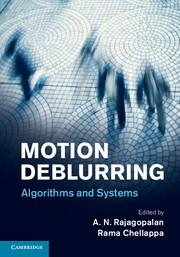Book contents
- Frontmatter
- Contents
- List of contributors
- Preface
- 1 Mathematical models and practical solvers for uniform motion deblurring
- 2 Spatially-varying image deblurring
- 3 Hybrid-imaging for motion deblurring
- 4 Efficient, blind, spatially-variant deblurring for shaken images
- 5 Removing camera shake in smartphones without hardware stabilization
- 6 Multi-sensor fusion for motion deblurring
- 7 Motion deblurring using fluttered shutter
- 8 Richardson–Lucy deblurring for scenes under a projective motion path
- 9 HDR imaging in the presence of motion blur
- 10 Compressive video sensing to tackle motion blur
- 11 Coded exposure motion deblurring for recognition
- 12 Direct recognition of motion-blurred faces
- 13 Performance limits for motion deblurring cameras
- Index
- References
7 - Motion deblurring using fluttered shutter
Published online by Cambridge University Press: 05 June 2014
- Frontmatter
- Contents
- List of contributors
- Preface
- 1 Mathematical models and practical solvers for uniform motion deblurring
- 2 Spatially-varying image deblurring
- 3 Hybrid-imaging for motion deblurring
- 4 Efficient, blind, spatially-variant deblurring for shaken images
- 5 Removing camera shake in smartphones without hardware stabilization
- 6 Multi-sensor fusion for motion deblurring
- 7 Motion deblurring using fluttered shutter
- 8 Richardson–Lucy deblurring for scenes under a projective motion path
- 9 HDR imaging in the presence of motion blur
- 10 Compressive video sensing to tackle motion blur
- 11 Coded exposure motion deblurring for recognition
- 12 Direct recognition of motion-blurred faces
- 13 Performance limits for motion deblurring cameras
- Index
- References
Summary
Motion blur is the consequence of relative motion between the camera and the scene within the camera's exposure (shutter) time. While a sharp photo might be restored computationally using deblurring algorithms, can we assist motion deblurring by modifying the imaging process itself? Motion deblurring systems modify the traditional image capture to simplify or help the subsequent deblurring process. Such systems include but are not limited to (a) coded exposure cameras which modulate the light integration pattern so as to make the resulting point spread function (PSF) invertible; (b) auxiliary low spatial resolution high frame-rate cameras to help in PSF estimation; and (c) auxiliary sensors such as gyroscopes/inertial measurement units (IMUs) to assist in PSF estimation. Current digital single lens reflex (SLR) cameras and lenses also incorporate image stabilization for handling limited motion blur, which will detect user hand-shake and shift the image parallel to the image plane appropriately. In this chapter, we describe coded exposure photography for motion deblurring.
Related work
Capture time solutions
Using a fast shutter speed (short exposure time) can reduce motion blur, but increases noise and penalizes static parts of the scene. High-speed cameras capture fast motion but require expensive sensing, bandwidth and storage, along with brilliant scene lighting. A high-speed camera also fails to exploit the inter-frame coherence. Edgerton (1951–63) has shown visually stunning results for high-speed objects using a modest exposure time but an extremely narrow-duration flash. Flash, however, is impractical in outdoor or distant scenes. In addition, it captures an instant of the action and fails to indicate the general movement in the scene.
- Type
- Chapter
- Information
- Motion DeblurringAlgorithms and Systems, pp. 141 - 160Publisher: Cambridge University PressPrint publication year: 2014



